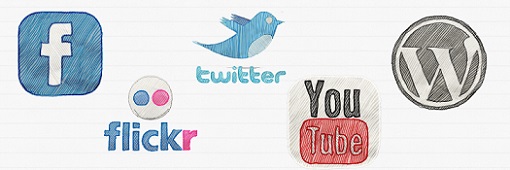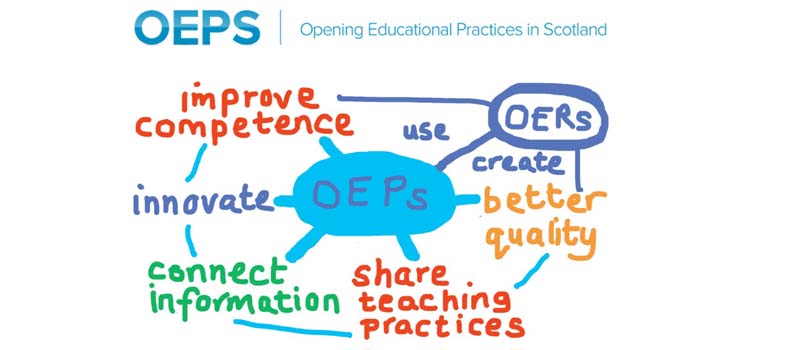5.3 Using social media in your context and open tools
Section 2.5 [Tip: hold Ctrl and click a link to open it in a new tab. (Hide tip)] highlighted the importance of digital literacy. This section explores the role of social media and open tools in open practice and highlights good practice examples.
Blogging, Twitter, open badges and social media

Another example of ‘opening’ up processes is, where appropriate, the development of open online courses or incorporating social media or blogging into a course’s activities. Some universities host courses on Wordpress, for example. Katie Sykes at Thompson Rivers University developed Lawyering in the 21st Century on Wordpress so that students could develop ‘a roadmap for [their] legal career’ whilst participating in regular 'partner meetings' and collaborating on a range of projects. The University of Dundee’s Medical School has also utilised Wordpress, whilst the University of Mary Washington has developed A Domain of One's Own, enabling students and teachers alike to host courses and blogs. To help support teachers in the effective use of Wordpress, educators at the University of British Columbia have developed an open course on open pedagogy: Teaching with Wordpress.
You could use Twitter or other social media (e.g. Pinterest) as a resource, as suggested by the University of Dundee's Natalie Lafferty:
Using Twitter for teaching
Effective use of social media in teaching is critical and Natalie spoke at length about how her own use of Twitter helped inform the way in which she encouraged students to engage with the platform:
And I think it’s partly because of how we, we think – oh! Let’s use Twitter in the classroom – without really thinking about how we use it as professionals. And as professionals we use it as a networking tool and that’s where my learning network is. I pose a question and I learn so much from people. And students have their Facebook groups but they don’t look more widely.
So it’s interesting when I’ve looked at Twitter more recently what I’ve tried to do is to say: Twitter is a place to filter and search for OER that’s validated by professionals.
And I did a teaching session recently with some medical students who are doing a BMsC in Teaching in Medicine and I said I want you to look up this hashtag #FOAMed and see what you see. And it was like ‘Gosh! I just didn’t realise there was this stuff on Twitter.’ And it opened their eyes to it because they’d been really put off as to how they’d used it previously in the curriculum. And they saw straight away that there was all this stuff that was really relevant and the fact that it was being shared by doctors and consultants and professors. And they realise that actually there is a sense of peer review and validation.
Because I think that’s always the issue people have around OER, is that well actually is it accurate? You know, all this kind of stuff. And I think certainly from the FOAMEd community what you do see there are people constantly giving feedback, people are improving and changing things. And things get updated much more readily than a textbook. And I think the challenge for me is how do we broaden what we’ve learnt in medicine across the institution ...
Other educators create videos as part of their course, or even use the videos to deliver lecture content with face-to-face time then dedicated to practical activity. Bernd Porr at the University of Glasgow has adopted a ‘flipped’ approach to his Digital Signal Processing (DSP) classes. Read Bernd’s story on the OEPS Hub, including tips for creating open access videos.
Whilst awarding a badge or statement of participation to learners for engaging with course materials and activities is not necessarily an open practice, if you are developing open material with an assessment element attached to it you might want to consider using open badges as a way of acknowledging your learners’ achievements. Borders College in Scotland is using open badges ‘… for best practice in Moodle use’ by educators and learners. You can read more about Borders College, and different badging platforms in JISC’s ‘So what are open badges?’ or review open badging platforms such as Mozilla Open Badges and Credly.
Perhaps, whilst developing your materials, you might want to get a range of perspectives on the course content and decide to solicit feedback through open peer review of your material (as in the case of this course) before you publish your finalised course. Or perhaps your students could use blogging or other social media for assignments? If you're not sure where to start, check out the short presentation ‘An introduction to Twitter for teachers’ before moving on to Section 5.6.
Use open tools
The Open Source Movement, which promotes collaborative development of openly available code, software and tools was mentioned briefly at the start of the course. You might look to explore, use and even develop this type of resource as part of your everyday practice. Using open source tools and software ensures that everyone has access to the software packages they need when accessing materials. For example, Moodle, the learning management system used by many universities, is open source. You can find a list of open tools in Section 5.6.
5.2 Sharing processes and outcomes
